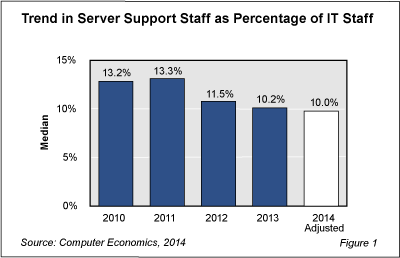Some analysts have been anticipating that data center jobs could be in long-term decline. Next-generation data centers built by cloud service providers such as Amazon and Google have incredibly low levels of support staff, and trends such as data center consolidation, virtualization, outsourcing, and data center automation contribute to higher productivity.
Until recently, our data had not provided evidence that these trends had significantly influenced server support staffing requirements for most organizations. In fact, when viewed as a percentage of the IT staff, data center personnel actually rose during the early part of the recession as IT organizations reduced staffing in less critical areas. While data center staffing may not have been actually rising, it also did not appear to be suffering from secular decline.
However, that trend reversed itself in 2011. Figure 1 from our study, Server Support Staffing Ratios, shows the server support staffing ratio took a sharp drop at the median level from 13.3% in 2011 to 11.5% in 2012. The reversal came as IT budgets began to recover, and the sharp decline reflects renewed growth in areas such as networking and application development staffing.

Since then, however, we see a more gradual confirmation of the trend. Since 2011, there has been a downward movement in the median ratio for server support staff as a percentage of the IT staff, from 11.5% in 2012 to an adjusted ratio of 10.0% in 2014. This decline may indicate that outsourcing, low levels of investment in data center infrastructure, and cloud computing is beginning to take its toll on server support staffing levels.
We caution that the median for 2014 has been adjusted to account for a change in our survey. In 2014, we created a new staffing category for communications personnel, and some of these IT staff members were drawn from the server support group. As such, we adjusted the 2014 median upward to make the data comparable with previous years. Still, while based on an estimate, the data suggests there is downward pressure on the server support staffing ratio.
Over the longer term, with rising investment in cloud infrastructure and applications, we anticipate continued downward pressure on server support staffing. That makes optimal data center staffing a moving target. What is the standard level of server support staffing in today’s data center? To answer that question, the full study provides four key metrics for benchmarking server support staff: server support staff as a percentage of the IT staff, users per server support staff member, physical servers per server support staff member, and OS instances per server support staff member. We provide these metrics for small, midsize, and large organizations. We also assess how industry sector can influence server support staffing ratios. We conclude with recommendations for improving server support productivity.
This Research Byte is a brief overview of our report on this subject, Server Support Staffing Ratios. The full report is available at no charge for Computer Economics clients, or it may be purchased by non-clients directly from our website (click for pricing).
Do you also need staffing ratios for other IT job functions? Consider this collection of all of our staffing ratio reports, which bundles them all into a single report at a significant discount: IT Staffing Ratios–Special Report Bundle.

